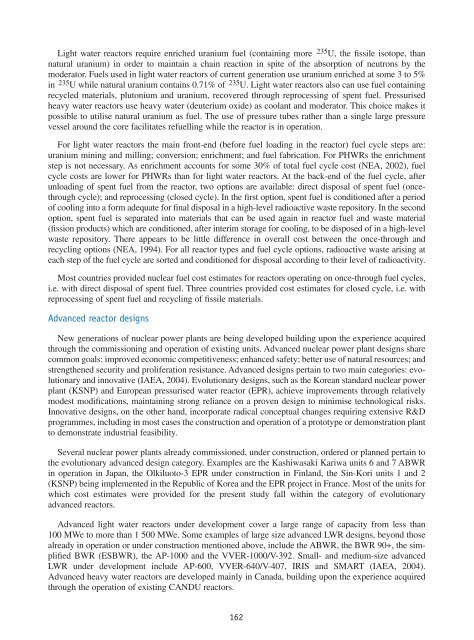Projected Costs of Generating Electricity - OECD Nuclear Energy ...
Projected Costs of Generating Electricity - OECD Nuclear Energy ...
Projected Costs of Generating Electricity - OECD Nuclear Energy ...
Create successful ePaper yourself
Turn your PDF publications into a flip-book with our unique Google optimized e-Paper software.
Light water reactors require enriched uranium fuel (containing more 235 U, the fissile isotope, than<br />
natural uranium) in order to maintain a chain reaction in spite <strong>of</strong> the absorption <strong>of</strong> neutrons by the<br />
moderator. Fuels used in light water reactors <strong>of</strong> current generation use uranium enriched at some 3 to 5%<br />
in 235 U while natural uranium contains 0.71% <strong>of</strong> 235 U. Light water reactors also can use fuel containing<br />
recycled materials, plutonium and uranium, recovered through reprocessing <strong>of</strong> spent fuel. Pressurised<br />
heavy water reactors use heavy water (deuterium oxide) as coolant and moderator. This choice makes it<br />
possible to utilise natural uranium as fuel. The use <strong>of</strong> pressure tubes rather than a single large pressure<br />
vessel around the core facilitates refuelling while the reactor is in operation.<br />
For light water reactors the main front-end (before fuel loading in the reactor) fuel cycle steps are:<br />
uranium mining and milling; conversion; enrichment; and fuel fabrication. For PHWRs the enrichment<br />
step is not necessary. As enrichment accounts for some 30% <strong>of</strong> total fuel cycle cost (NEA, 2002), fuel<br />
cycle costs are lower for PHWRs than for light water reactors. At the back-end <strong>of</strong> the fuel cycle, after<br />
unloading <strong>of</strong> spent fuel from the reactor, two options are available: direct disposal <strong>of</strong> spent fuel (oncethrough<br />
cycle); and reprocessing (closed cycle). In the first option, spent fuel is conditioned after a period<br />
<strong>of</strong> cooling into a form adequate for final disposal in a high-level radioactive waste repository. In the second<br />
option, spent fuel is separated into materials that can be used again in reactor fuel and waste material<br />
(fission products) which are conditioned, after interim storage for cooling, to be disposed <strong>of</strong> in a high-level<br />
waste repository. There appears to be little difference in overall cost between the once-through and<br />
recycling options (NEA, 1994). For all reactor types and fuel cycle options, radioactive waste arising at<br />
each step <strong>of</strong> the fuel cycle are sorted and conditioned for disposal according to their level <strong>of</strong> radioactivity.<br />
Most countries provided nuclear fuel cost estimates for reactors operating on once-through fuel cycles,<br />
i.e. with direct disposal <strong>of</strong> spent fuel. Three countries provided cost estimates for closed cycle, i.e. with<br />
reprocessing <strong>of</strong> spent fuel and recycling <strong>of</strong> fissile materials.<br />
Advanced reactor designs<br />
New generations <strong>of</strong> nuclear power plants are being developed building upon the experience acquired<br />
through the commissioning and operation <strong>of</strong> existing units. Advanced nuclear power plant designs share<br />
common goals: improved economic competitiveness; enhanced safety; better use <strong>of</strong> natural resources; and<br />
strengthened security and proliferation resistance. Advanced designs pertain to two main categories: evolutionary<br />
and innovative (IAEA, 2004). Evolutionary designs, such as the Korean standard nuclear power<br />
plant (KSNP) and European pressurised water reactor (EPR), achieve improvements through relatively<br />
modest modifications, maintaining strong reliance on a proven design to minimise technological risks.<br />
Innovative designs, on the other hand, incorporate radical conceptual changes requiring extensive R&D<br />
programmes, including in most cases the construction and operation <strong>of</strong> a prototype or demonstration plant<br />
to demonstrate industrial feasibility.<br />
Several nuclear power plants already commissioned, under construction, ordered or planned pertain to<br />
the evolutionary advanced design category. Examples are the Kashiwasaki Kariwa units 6 and 7 ABWR<br />
in operation in Japan, the Olkiluoto-3 EPR under construction in Finland, the Sin-Kori units 1 and 2<br />
(KSNP) being implemented in the Republic <strong>of</strong> Korea and the EPR project in France. Most <strong>of</strong> the units for<br />
which cost estimates were provided for the present study fall within the category <strong>of</strong> evolutionary<br />
advanced reactors.<br />
Advanced light water reactors under development cover a large range <strong>of</strong> capacity from less than<br />
100 MWe to more than 1 500 MWe. Some examples <strong>of</strong> large size advanced LWR designs, beyond those<br />
already in operation or under construction mentioned above, include the ABWR, the BWR 90+, the simplified<br />
BWR (ESBWR), the AP-1000 and the VVER-1000/V-392. Small- and medium-size advanced<br />
LWR under development include AP-600, VVER-640/V-407, IRIS and SMART (IAEA, 2004).<br />
Advanced heavy water reactors are developed mainly in Canada, building upon the experience acquired<br />
through the operation <strong>of</strong> existing CANDU reactors.<br />
162

















